How Art Changes the Way You See the World
![]()
Final year around this fourth dimension, artnet News' one-time Editor-in-Chief Benjamin Genocchio penned a heartfelt and highly personal list of 25 ways to alter the art world for the better. This year, in the wake of the presidential election and close to the eve of Thanksgiving, artnet News has turned to respected colleagues and friends to crowdsource opinion on how to improve the practices, values and aspirations of art'southward expanding and restless international community.
Below are 28 of our respondents' alternately pithy and expansive submissions. We have chosen to publish their comments pretty much as we received them. Their original voices, we believe, matter today as much the content of their proposals.
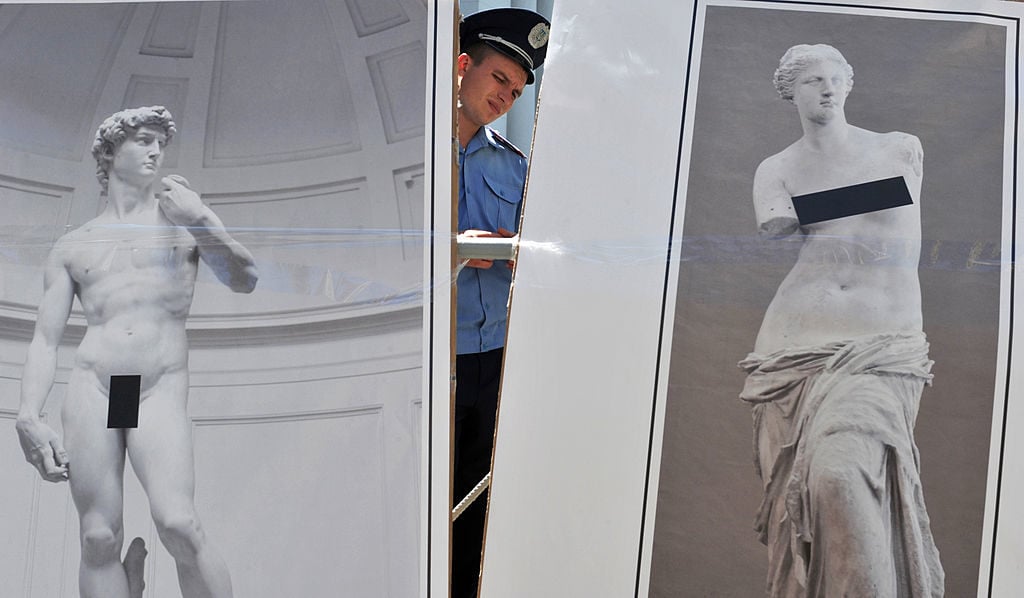
A policeman stands guard behind placards depicting "censored" masterpieces of earth fine art during auction in front of Ukraine's President Viktor Yanukovych office in Kiev in 2011. Courtesy of SERGEI SUPINSKY/AFP/Getty Images.
1. "Let's cease the retrograde conversations around censorship (and self-censorship). Engage your enemy. Cease trying to bulldoze them into hiding."
—Adam Abdalla, President, Cultural Counsel
2."Lessen the power of the market."
—Cecilia Alemani, Director and Chief Curator of High Line Art
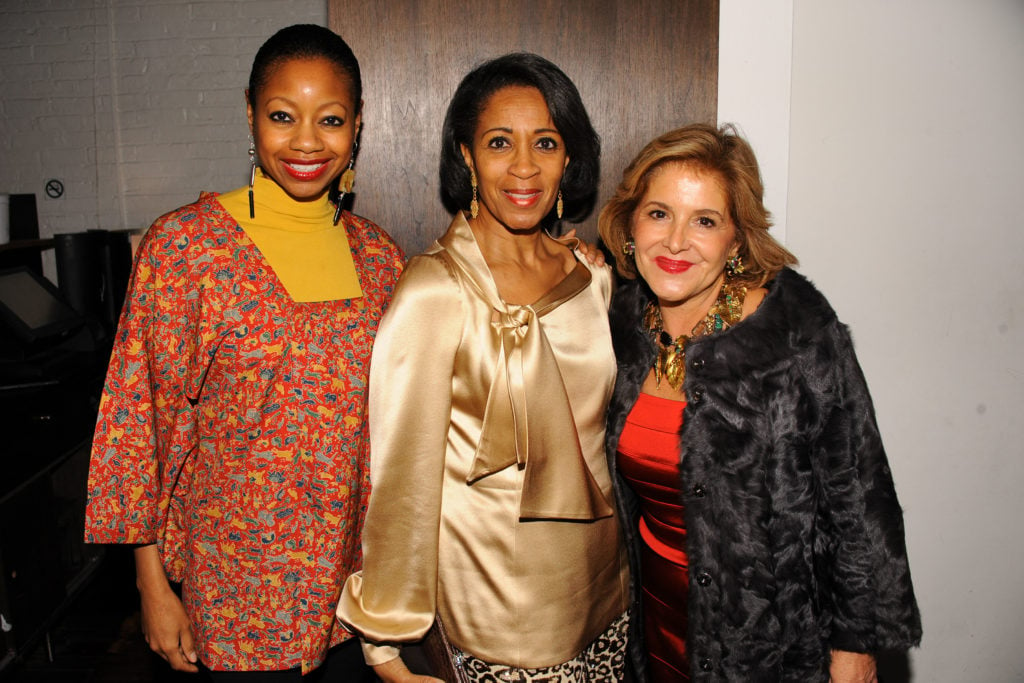
Donnamarie Baptiste, Amelia Ogunlesi, Leila Heller at Leila Heller Gallery.
©Patrick McMullan. Photo by Paul Bruinooge/PatrickMcMullan.com.
3. "Fund marginalized communities directly and in meaning amounts (how many times have we seen people of color used for funding, but non one person in the organization has been to the communities they supposedly serve?). Heed to the people most affected past injustice. Funding leadership does nothing if organizations aren't hiring people of colour to start with. I've known quite a few terrible leaders of organizations that went through leadership preparation. Not to mention, that none of that leadership training has brought about more inclusiveness because—here we are. Every bit the pop activist adage goes: 'When you're accustomed to privilege, equality feels like oppression." There's no equality in the arts because the status quo doesn't want it. THAT is what needs to change.'"
—Donnamarie Baptiste, Arts Managing director and Producer
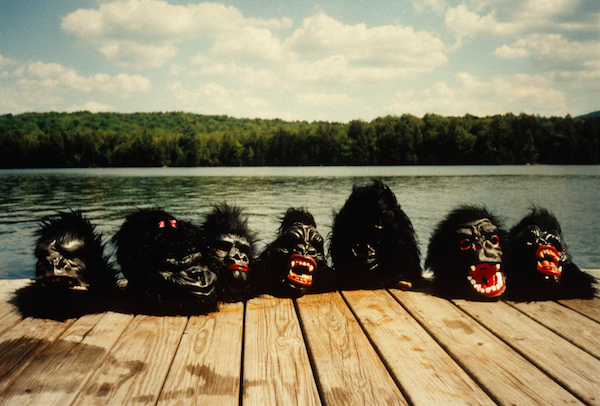
The Guerrilla Girls BroadBand's show "#ProvokeProtestPrevail," at the Bruce High Quality Foundation University.
4. "Arts education cannot afford to solely be the province of the well off. And it cannot afford to be circumscribed solely by the market place centers of New York and Los Angeles. A truly democratic nation demands that our civilization reflect a diverseness of ideas, that artists come from all walks of life, and that we artists model the critical and poetically nuanced dialogue nosotros seek for culture at large. In other words, artists demand to assist each other.
We demand to share ourselves—our passions and our intelligence—with artists nosotros don't know already, with artists that don't look similar usa, that don't live where we do. Heck, we'll even pay you to do it! BHQFU is partnering with ArtCenter/South Florida to recruit five artists from anywhere, at any stage in their trajectory, working in any discipline to live and work in Miami for three months while they help united states of america to develop a complimentary arts curriculum for the future. You can find out more than and apply hither."
—The Bruce High Quality Foundation, Artists and Educators
5. "Make MUSEUMS FREE! In Houston, the Contemporary Arts Museum Houston, The Menil Collection, the Blaffer Museum of Art, Project Row Houses, and Diverseworks are amongst the many cultural institutions presenting globe-class exhibitions that one tin can visit without paying access. This has been the example for generations, with the event that our local communities have pride and ownership of civilization in a way I've not experienced in whatever other city. Nosotros are "their museums"! With audiences who are incredibly diverse in terms of historic period, ethnicity, economic ability, and museum-going experience, we're all the richer for it!"
—Dean Daderko, Curator, Contemporary Arts Museum Houston
6. "Language is going to be important as we motility forwards. There needs to exist an embargo on bad language in poor press releases, too as ambulance chasing titles for exhibitions. In 2017, let'south not run into the art globe casually dropping the term "post-truth" into every printing release. Ditto with "temporality"—permit information technology become. Delight no more "notions of" or "traditional parameters." Keep the language direct and clear.
Repossess "clear optics, full hearts"… and try not to lose."
—Dexter Dalwood, Artist
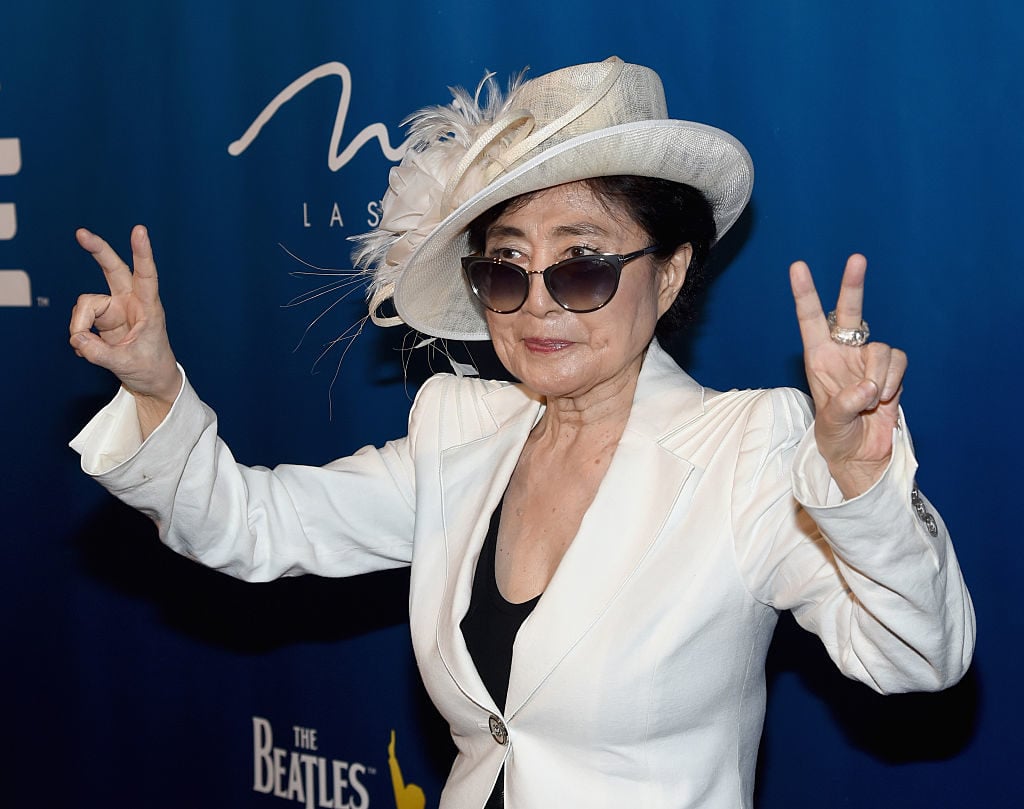
Yoko Ono in 2016. Photo by Ethan Miller/Getty Images for Cirque du Soleil.
vii. "Firstly, I think Fluxus actions should be incorporated into physical education classes. I would honey to run into a P.Due east. curriculum past, say, Yoko Ono. Secondly, I'd like to propose required trust exercises betwixt collectors and their fine art advisors. Better yet, these should be required for the completion of every transaction. Lastly, no more than click allurement."
—Ingrid Dudek, Manager of Contemporary Fine art at Bonhams
8. "I suggest all visitors (including collectors, curators, advisors and dealers likewise as the public at large) to art museums, art galleries and art fairs spend equally much fourth dimension looking at works of art as they do taking pictures, texting and phoning."
—Michael Findlay, Manager, Acquavella Galleries
9. "What if the fine art world was a lot more integrated into the world world? What if the art globe and the world world existed in a state of mutual accountability to ane another? What if art was valued equally a shared cultural transmission that brings people together despite difference, instead of as a luxury skillful that promotes class sectionalisation? What if artistic process was valued equally concretely equally art objects? What if the art world'south purpose was to increase net inventiveness, and aggrandize the options and vision of a population? What if artists were able to value their ain artistic products, processes, and outcomes? What if artists felt comfortable working beyond the affirmation of the art globe?"
—Deborah Fisher, Executive Director, A Bract of Grass
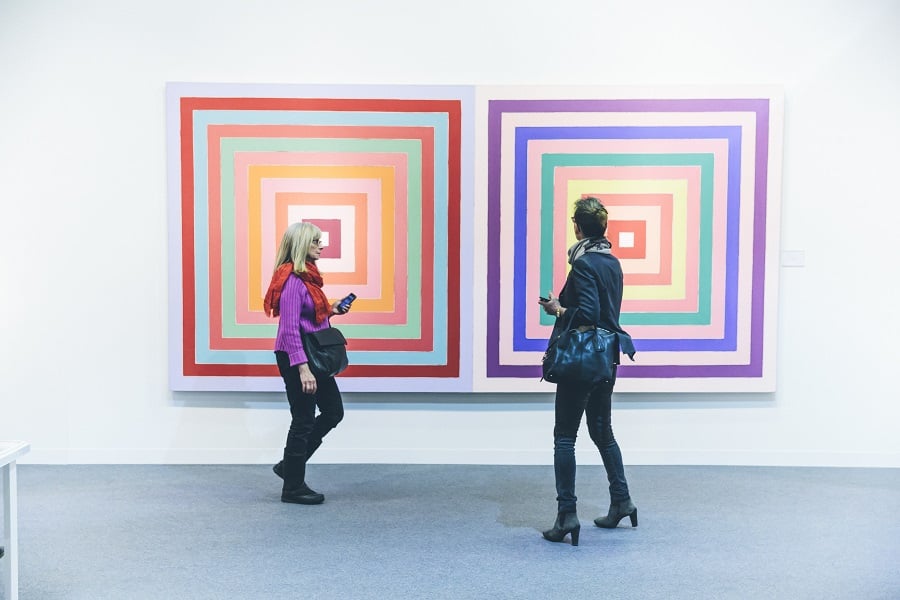
Photo: Courtesy of Roberto Chamorro for The Arsenal Show.
10. "One way to make the art world a ameliorate place is to substantially raise the wages for curatorial and other staff at museums to reflect the rapid cost of living increases in major metropolitan centers. Without living wages for curators, museums will no longer be able to attract the best and brightest talent."
—Ben Genocchio, Executive Director, The Armory Show
11. "It'south painfully clear that the fine art world, like and then many other cherished enclaves of liberalism, utterly failed the states in Nov. It'south at present time for a wholesale reconsideration of the part art (and the art community) plays in society. Is information technology zone of Callimachean complication, referentiality, and obscurantism, like the Library of Alexandria before Caesar burnt information technology to the ground? Or is it a place where profound and important ideas are given the rhetorical wings to reach a widespread audience beyond the belfry? Is at present a time to épater les conservative above all else? Should art about fine art most fine art be more valued than art well-nigh our time, and pushed by a delinquent market into every facet of our institutions and public spaces? These are questions we should be asking ourselves."
—Andrew Goldstein, Main Digital Content Officer of Artspace | Phaidon
12. "Ban all "special exhibitions" in museums for a year. Render fine art lovers to the erstwhile-fashioned joys of earthworks deep into a permanent collection."
—Blake Gopnik, Critic at Large, Artnet News
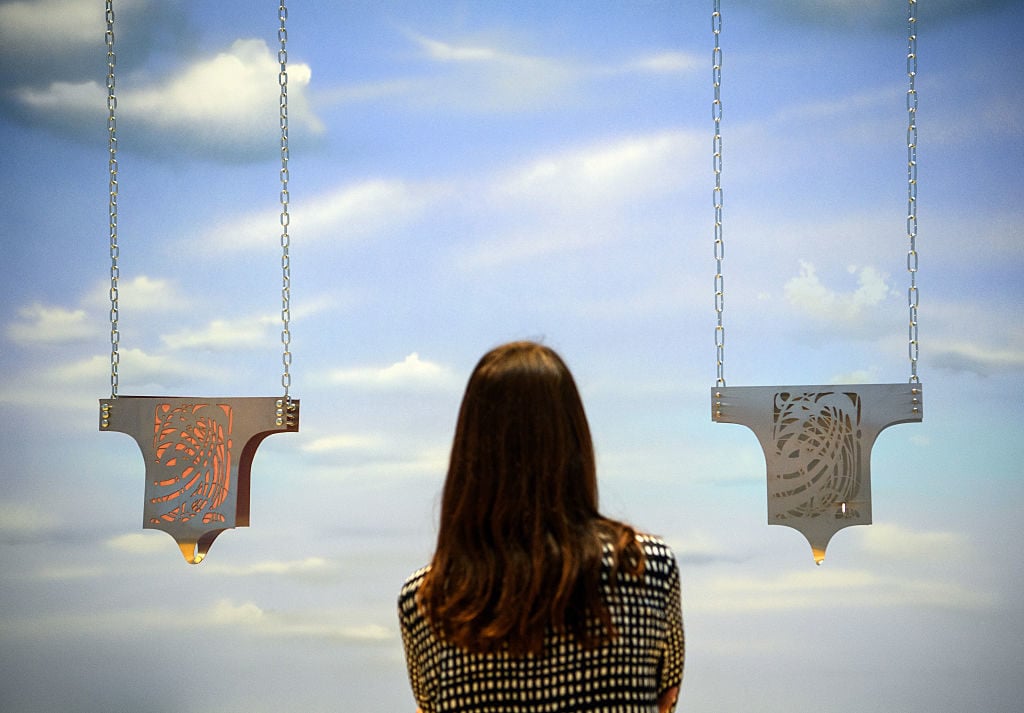
Anthea Hamilton, Guimard Chastity Belt. Printing preview for the 2016 Turner Prize at Tate Britain on September 26, 2016 in London, Photograph by Carl Court/Getty Images.
13. "Artists' re-sale right should apply to all works sold at auction within seven years of leaving the artist's studio. If the maker is not alive, cannot be reached or is not interested in the actress coinage, the money should be used to fund young artists or art education. Finer, this is a flip tax."
—Dave Harper, Contained Curator and Consultant
xiv. "Notice your trusted news sources and consult them everyday."
—Danielle Jackson, Co-Founder, Bronx Documentary Middle
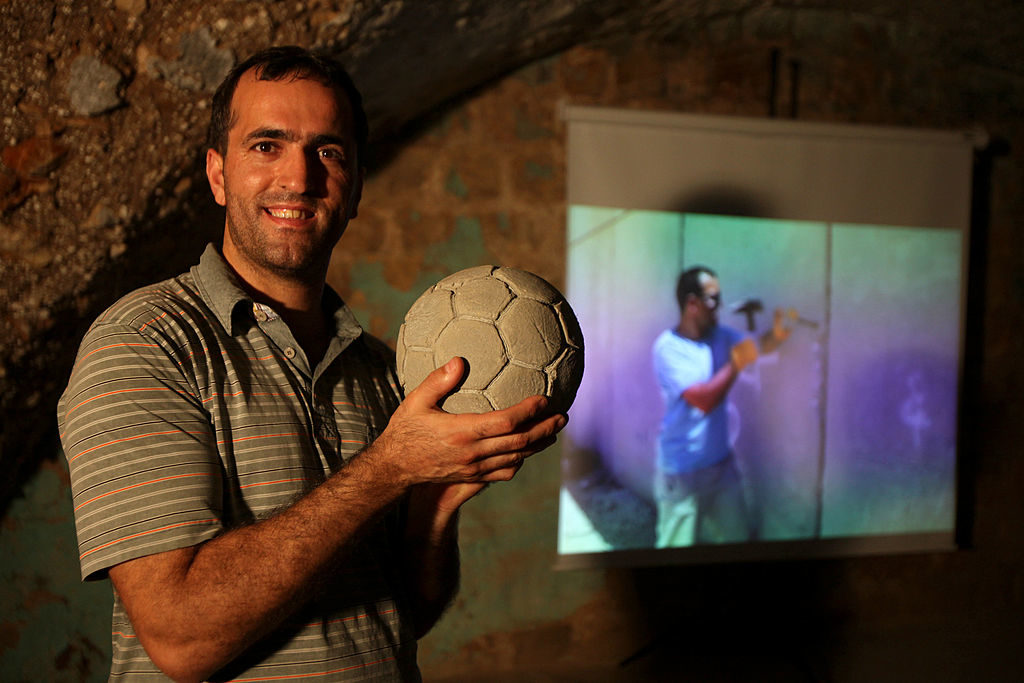
Khaled Jarrar in 2012. Courtesy of ABBAS MOMANI/AFP/Getty Images.
xv. "Afterwards returning from my exhibition "Castles Built From Sand Will Fall" in Dubai, I want to say that if nosotros tin can't proceed the sustained optimism we will neglect equally humans and as artists."
—Khaled Jarrar, Artist
16. "For those in the nonprofit sector: Present work that speaks truth to power and work that speaks for the disenfranchised. Respect artists who take a indicate of view by allowing them to clear information technology. Don't exist gratuitous. Exist thoughtful. And most of all, recall modify is a marathon, non a sprint."
—Harry Philbrick, Managing director Philadelphia Gimmicky
17. "Changing the fine art world is not really a different proffer than changing the world at this point. In the face of a Republican President and Congress, modify is going to have to come from us, if we are talking almost making the fine art globe a better identify. I think we need to seriously consider unionization, both pragmatically to address the shared weather condition of our labor, and at the symbolic level to demonstrate political solidarity with the working grade."
"Working Artists and the Greater Economic system (West.A.G.East.) is currently working on proposals for that wedlock edifice, and they need whatsoever we tin donate right at present to make information technology happen. My physical proffer is to brand a donation to W.A.K.Due east. immediately. My less concrete suggestion is to beginning thinking less about the role of the artist as an exceptional individual and more as a shared group identity."
—William Powhida, Artist
18. "Initiate difficult conversations with people who may be different from y'all or with whom you may disagree. The art globe, at its all-time, points to pressing issues in our world and in our lives. It's time for the art earth to go along to extend its reach across its familiar and comfortable confines, to engage with communities in diverse means, and engage with one another, especially where conflict lies."
—Yael Reinharz, Executive Managing director, Artis
19. "Less art fairs, more focus on exhibitions. Art fairs should not employ young galleries as curator fodder, forcing them into showing unsellable "project" sections at the fairs' periphery to give these fairs credibility while the big boys rake in millions at the center. The large galleries should pay an extra five percent actress to subsidize the younger galleries booths so that they don't go broke even if they sell out. Criticism should have a voice again, and collectors should take advice based on real critique not auction records."
—David Risley, Director David Risley Gallery
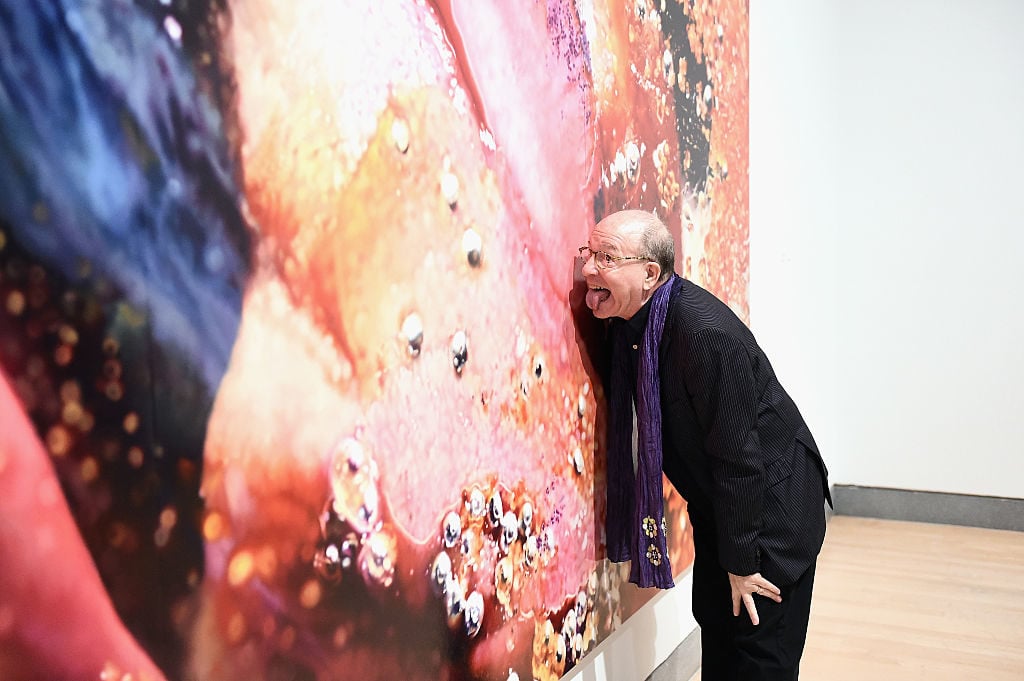
Jerry Saltz attends opening for Marilyn Minter and Iggy Pop at the Brooklyn Museum in 2016. Photo by Nicholas Hunt/Getty Images for Brooklyn Museum.
twenty. "Here'southward my listing of suggestions to improve the art world:
- Ten collectors should forego the buy of 1 $20 1000000 work of art by Christopher Wool, Jeff Koons, Damien Hirst, Richard Prince, Wade Guyton, Rudolph Stingel, Gerhardt Richter, that guy Adrian Ghenie, or any of those artists—great and terrible—in the parallel fine art earth of loftier-priced auctions. The $100 meg should exist used instead to buy a building somewhere in New York. The spaces in said edifice should be rented at cost to gallerists and to artists for studios.
- Sotheby's should use the profits from the sale of iii Picassos, a Modigliani, a de Kooning, and two Richters to sell its York Avenue building at cost to Memorial Sloan Kettering Hospital and vacate that neighborhood, to assistance further the tremendous work Slone Kettering does for so many in pain.
- Galleries should make a pact to deny sales to any collector who self-proclaims support for Trump. (I know this could break the bank and put usa all out of business, but I experience foul.)
- Boycott Mnuchin Gallery as long equally Steven Mnuchin is associated with president-elect Trump.
- Cry havoc and let sideslip the dogs of state of war come January xx.
- Art blogs should finish continually reporting auction news (except for our wonderful art-world market maniac, Kenny Schachter). They only matter to 125 people, none of them artists, and have nothing to practice with the inner life of art.
- Don't post nutrient pics on Instagram anymore."
—Jerry Saltz, Senior Fine art Critic, New York Mag
21. "Love Art World,
Stop facilitating the tax evading habits of wealthy art collectors. You're robbing your communities of much needed acquirement to improve infrastructure and social services."
—Jonathan Schwartz, President/CEO Atelier4
22. "The art world is non an entity apart from the real world. If it were and then, art would develop in a vacuum. In my opinion, one style to make the small microcosm of the art world ameliorate and hopefully connect with the real world is to go on enough room for art's essence—for its questioning processes, for the way it opens new doors into our agreement of ourselves and the world, for its understanding and acceptance of the Other, for its ability to remember exterior the box.
"As in the larger society, no ane can deny the current predominance of the omnipotent market (at least for the moment), which has opened up a blatantly large dichotomy between the significance of fine art and its monetary value. Merely we must discover a way to allow true art to thrive in the shadow of this art market.
"How can this exist achieved? For the art earth's stakeholders—artists, teachers, curators, gallerists, collectors, museum directors, critics, journalists and fine art lovers in general—it means because art less every bit an accessory and more as a set of principles that need to be dedicated, together, and across grade and ideological lines."
—Alain Servais, Art Collector
23. "Erase the lack of social commitment from the fine art earth."
—Bosco Sodi, Artist
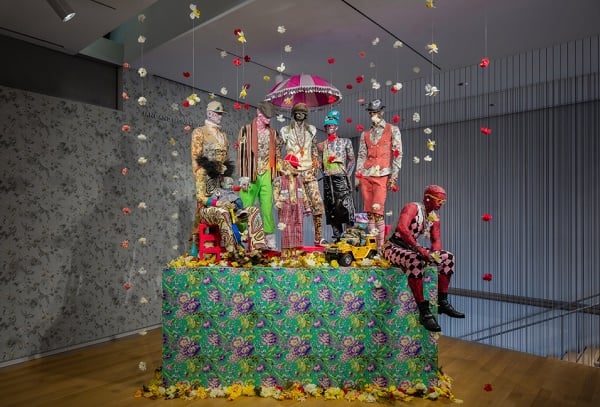
Ebony G. Patterson, Expressionless Trees (installation view), (2015). Courtesy of Butcher Walsh © and Museum of Arts and Design.
24. "Remake art education! The high cost of art school continues to define who makes the visual culture that becomes visible in the land; in other words, who can enter into the elite spheres of both institutions and the market and farther influence future generations. While some measures are taken to create balance, generally the cost of an art education at the institutions that open doors is prohibitive to all only a few.
Pay fine art faculty meliorate. Both private and public schools pay their predominantly function-time faculty too little to live on, let lone give them the benefits they demand to teach and bring their voices and practices to instruction
Foundations should fund operational expenses (staff and rent) at small to medium-sized arts organizations, particularly those outside of the main art centers, and then that they can do the important work of representing underrepresented artists, media and ideas in regions with less robust arts institutions.
Foundations should fund artists directly and brand grants renewable.
Stop normalizing art as a luxury good.
Work for diversity, equity and parity in the arts.
Gloat the piece of work of education departments. Write about it, talk about it, nourish information technology. These are the alternative organizations within our institutions doing some of the best work in the arts.
Put artists in leadership positions, not just in art organizations merely in civic organizations. Inside the arts, recognize artists as the experts in their fields, earlier curators, collectors, foundations, and critics, and respect their knowledge by putting them on boards, in leadership positions and in other positions of influence.
Deconstruct the entirely white, cis and predominantly heteronormative staff in charge of administrating and directing civilization."
—Shannon R. Stratton, William and Mildred Lasdon Chief Curator, Museum of Arts and Design

Orhan Pamuk at the Museum of Innocence. Photograph via the Museum of Innocence.
25. "I've been thinking a lot nearly Orhan Pamuk'south "Mod Manifesto for Museums." This passage in detail seems especially relevant to me now: "Nosotros do not need more than museums that attempt to construct a historical narrative of our society and community equally a narrative of faction, nation and state. Nosotros all know that ordinary and everyday stories are richer, more homo and above all more joyful." We need to pay attention to the art that fine art expresses the humanity of these ordinary, everyday voices, and it is imperative that museums provide a safe place in which they can be heard."
—Lisa Sutcliffe, Curator of Photography and Media Arts, Milwaukee Art Museum
26. It is now even more urgent to piece of work together to champion and protect inclusive spaces for all people, in particular people of colour, people of non-binary gender, and folks of diverse backgrounds—whatever and all voices who have been marginalized from the mainstream. Given the weight of our new political climate, we must take this responsibility very seriously and get to work creating the earth we want to live in.
—Vanessa Thill, Curator at Large, the Knockdown Center
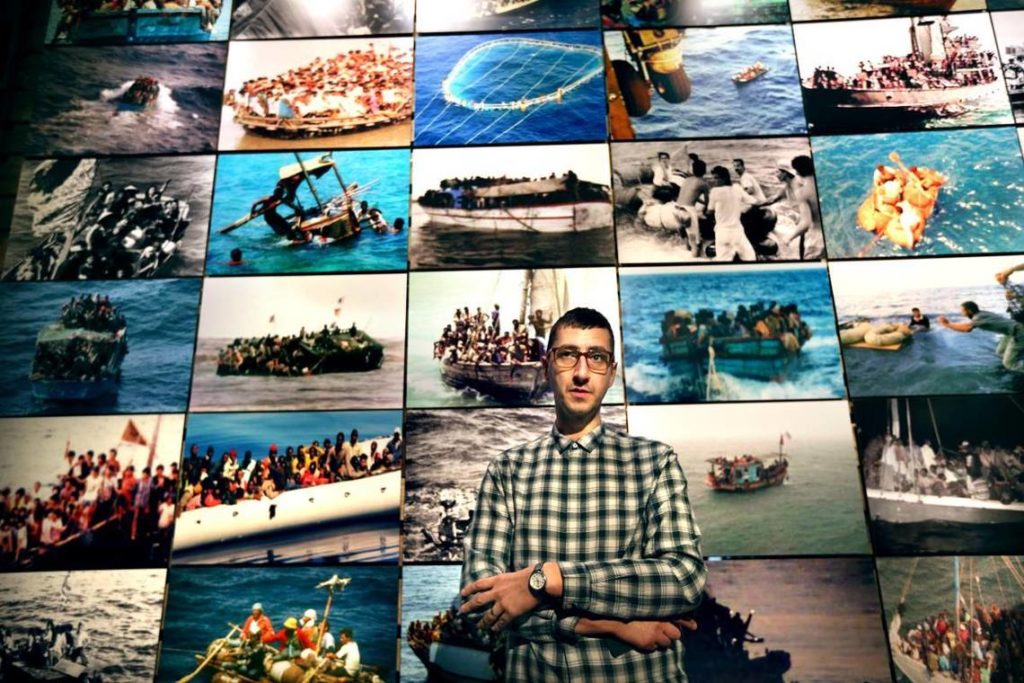
Niels Van Tomme. Photo courtesy of De Appel Arts Center, Amsterdam.
27. "We are continuously, and oftentimes precariously, working for the bettering of the globe through civilisation. Even though children are the future world nosotros're building, they're not included in our supposedly progressive worldviews and the professional person structures we navigate and create. So this would be my challenge to art workers internationally: Is information technology possible to devise new ways in which children are nurtured through the cultural activities nosotros devise, non as an afterthought through strictly formatted educational programs, but in ways in that shape and feed the content and structure of cultural activities? Retrieve about information technology."
—Niels Van Tomme, Director, Die Appel
28. "To change the art world for the better, artists and art institutions can back up collective efforts by providing infinite, resources, and critical reflection. Great art allows people to communicate across differences of opinion, experience, and expertise. Artistic practices of listening, healing, analyzing, envisioning, creating, and celebrating make interdisciplinary models for economic justice possible. We would not have community safety initiatives, tenants rights organizations, community country trusts, or freedom schools without the imagination and dedication of many artists.
"As white people wake upwardly to the reality that white supremacy threatens public health on a daily basis, nosotros must follow the atomic number 82 of black and dark-brown artists and organizers who have been under siege for centuries and who have always been leaders in the solidarity art economy. In New York Urban center, this means following the lead of groups similar El Puente, Fourth Arts Cake, The Laundromat Projection, THE POINT, Urban Bush Women, and groups affiliated with the Naturally Occurring Cultural Districts of NYC.
"To change the fine art world for the meliorate, we tin can start past realizing that another economic system in the arts is not simply possible—it already exists. By supporting the long-term work of arts groups that nurture equitable, place-based initiatives, we can strengthen and connect to an art economy of solidarity in New York Urban center and beyond." (The previous text is a "summary" of a presentation given by Woolard on Friday, November 18, 2016, to the National Endowment for the Arts on the occasion of its 50th anniversary celebration)
—Caroline Woolard, Artist and Organizer
Follow Artnet News on Facebook:
Want to stay ahead of the art world? Subscribe to our newsletter to get the breaking news, middle-opening interviews, and incisive critical takes that drive the conversation forward.
Source: https://news.artnet.com/art-world/28-ways-to-change-the-art-world-757595
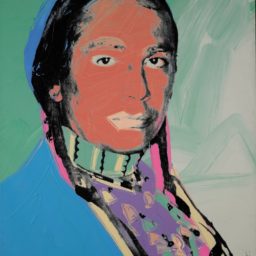
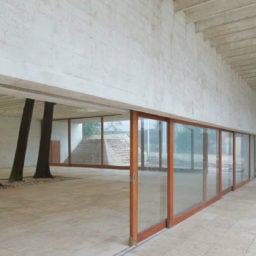
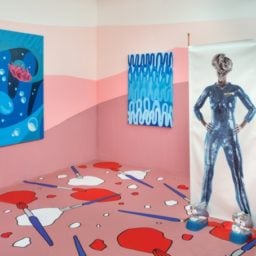
Posting Komentar untuk "How Art Changes the Way You See the World"